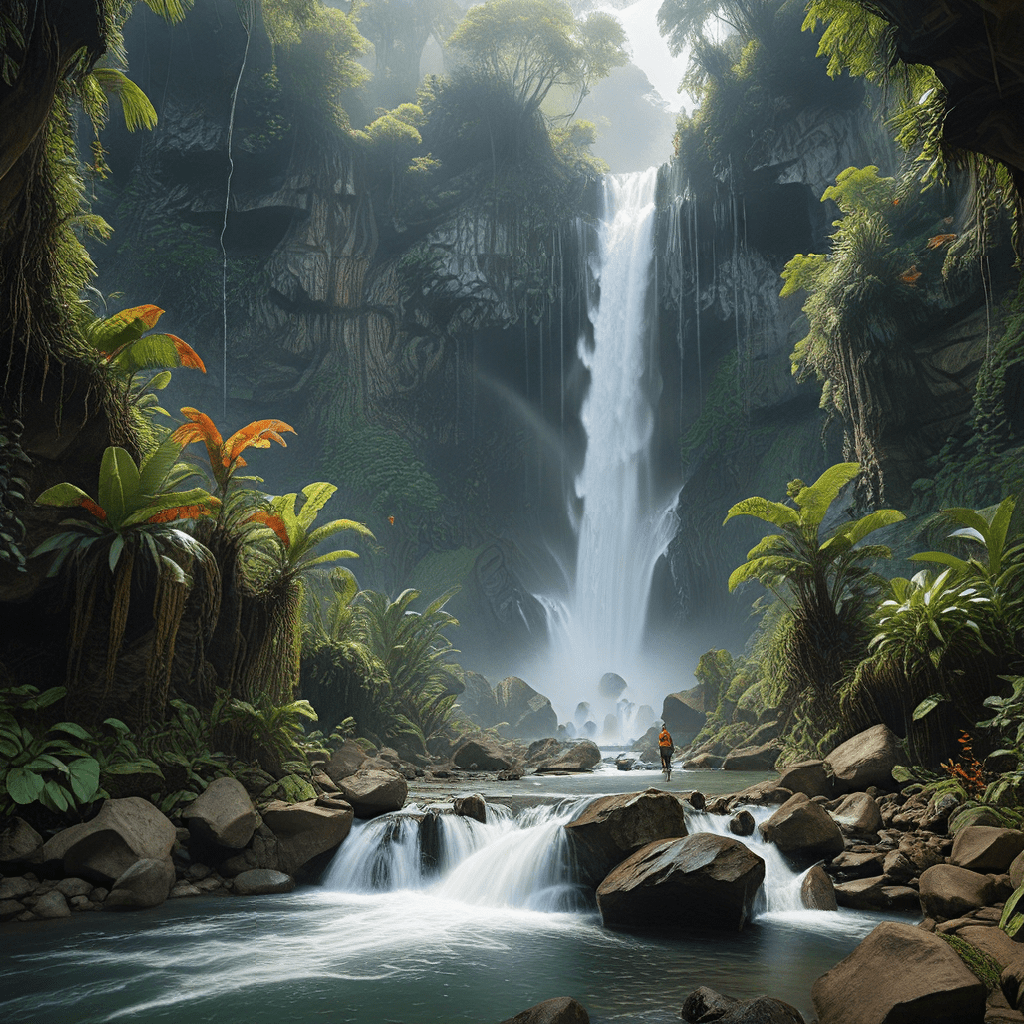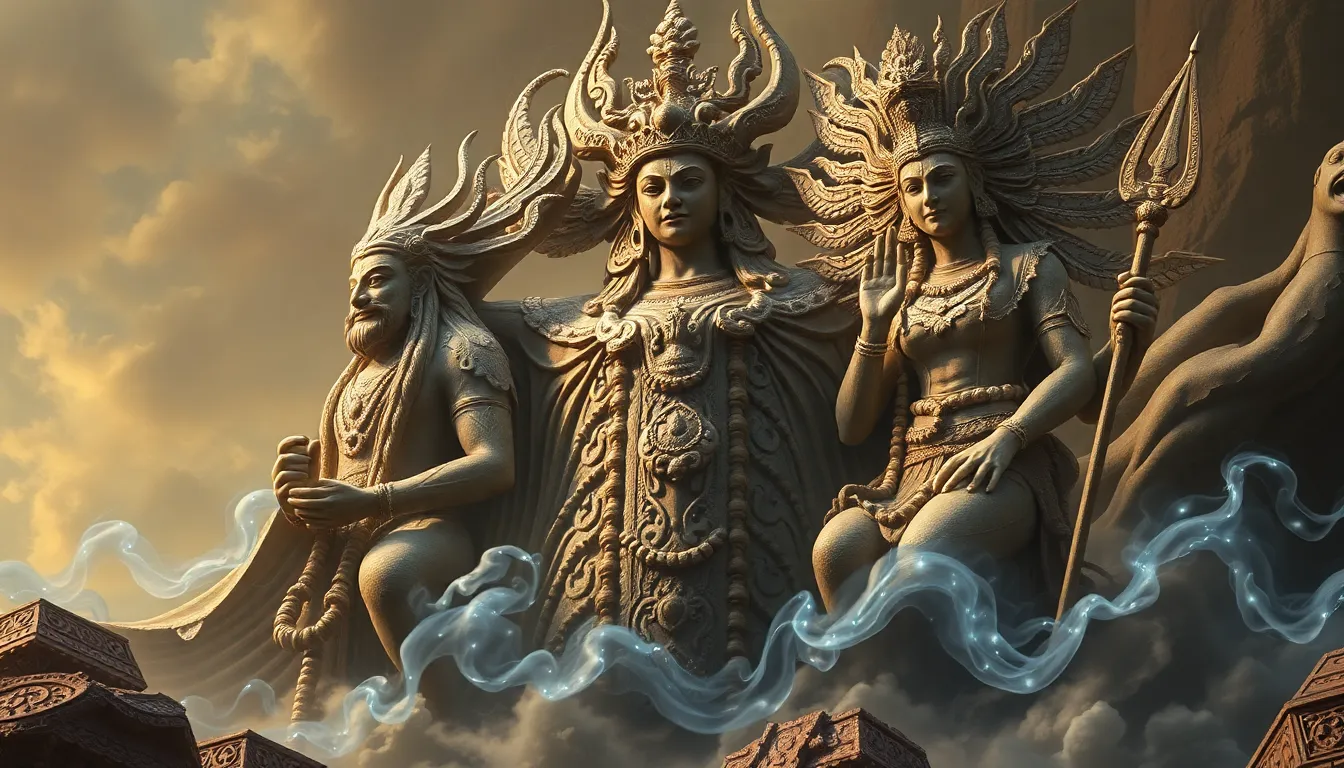The Allure of the Waterfalls: A Gateway to the Divine
In the heart of Indonesia, where lush jungles meet towering mountains, lie hidden treasures of nature: waterfalls. These cascading wonders are not just breathtaking spectacles; they are central to the rich tapestry of Indonesian folklore, imbued with deep mystical significance. For centuries, Indonesians have viewed waterfalls as gateways to the divine, places where the boundaries between the human and spiritual worlds blur.
The sheer force and beauty of these natural phenomena inspire awe and reverence. The thundering roar of the water, the misty spray, and the cool, refreshing air create an almost sacred atmosphere. The waterfalls are seen as places of immense power, where spirits reside and the veil between the tangible and intangible worlds is thin. This perception has shaped numerous myths and legends, weaving waterfalls into the fabric of Indonesian culture.
Mythical Waterfalls as Portals to Other Worlds
Many Indonesian tales speak of waterfalls as portals to other realms: hidden kingdoms, magical forests, or even the afterlife. These mythical waterfalls often serve as paths for heroes, spirits, or deities seeking passage between worlds. They may act as bridges between the mundane and the supernatural, connecting human existence to the realm of the divine.
For example, in the mythology of the Dayak people of Borneo, there exists a legend of a waterfall called "Air Terjun Bukit Bungkuk" (Bent Back Waterfall). This waterfall is said to be a portal to a hidden world where the spirits of the dead reside. It is believed that the souls of the departed make their way to this afterlife through this mystical cascade. This tale underscores the symbolic connection between waterfalls and the journey beyond the earthly realm.
Waterfalls as Sites of Transformation and Rebirth
The transformative power of water is a recurring theme in mythology worldwide, and Indonesian folklore is no exception. Waterfalls, with their ceaseless flow and ability to reshape landscapes, are seen as potent symbols of transformation and rebirth. The act of bathing in or drinking water from a sacred waterfall is often associated with purification and renewal, signifying a shedding of the old and a welcoming of the new.
The legend of "Air Terjun Tumpak Sewu" (Thousand Waterfall) in East Java exemplifies this concept. This waterfall is said to be imbued with magical properties, capable of healing the sick and bestowing good fortune. Pilgrims often visit the waterfall to perform cleansing rituals, seeking spiritual purification and renewal. The waterfall's power to cleanse and transform resonates with the ancient belief that water can wash away negativity and usher in a fresh start.
Echoes of Ancient Beliefs: The Sacredness of Water
The reverence for waterfalls in Indonesian mythology stems from the profound respect for water in ancient beliefs. Water is considered a vital element, essential for life and fertility. It is seen as a force that nourishes and sustains, but also carries the power to destroy. This dual nature of water is reflected in the mystical attributes associated with waterfalls.
Many cultures in Indonesia associate water with the divine feminine. Waterfalls, as powerful expressions of this force, are often seen as embodiments of goddesses or female spirits. Offerings are made to these entities, seeking their blessings and protection. The sacredness of waterfalls, therefore, is rooted in a deep respect for the life-giving and life-sustaining essence of water.
The Role of Spirits and Supernatural Beings
Waterfalls in Indonesian folklore are often inhabited by spirits or supernatural beings. These entities may be benevolent, guiding those who seek their help, or malevolent, guarding the secrets of the waterfall and punishing those who trespass. The presence of these supernatural beings adds another layer of mystique and danger to the already awe-inspiring beauty of the waterfalls.
For example, the legend of "Air Terjun Sedayu" (Sedayu Waterfall) in West Java tells of a powerful water nymph who dwells beneath the cascade. This nymph is said to grant wishes to those who are pure of heart and offer her gifts, but she will curse those who disrespect her or her sacred dwelling. This tale serves as a reminder of the importance of showing respect to the spirits who reside within nature's wonders.
Mythical Waterfalls in Indonesian Folklore: Tales of Heroes and Villains
Indonesian folklore is brimming with tales of heroes and villains, and waterfalls often play a pivotal role in these stories. These mythical cascades serve as settings for epic battles, trials of strength, and encounters with supernatural beings. The power and mystery associated with waterfalls shape the narratives, adding depth and intrigue to the folklore.
One such tale is the legend of "Air Terjun Cunca Liang" (Cunca Liang Waterfall) in West Nusa Tenggara. The story revolves around a brave warrior who sought to defeat a fearsome dragon that terrorized the local villagers. The dragon resided near the waterfall, guarding its treasure trove. The warrior, with his sword and shield, bravely faced the dragon in a fierce battle, finally slaying the beast and liberating the villagers from its reign of terror. The waterfall became a symbol of courage and victory, forever etched in local memory as the place where the hero vanquished the dragon.
Another legend, "Air Terjun Bidadari" (Fairy Waterfall) in West Java, tells the story of a beautiful princess who was transformed into a fairy and forced to live near the waterfall. She was cursed by an envious witch, stripped of her human form and confined to the magical cascade. The story highlights the theme of betrayal and the transformative power of nature, with the waterfall serving as a poignant reminder of the princess's tragic fate.
These tales demonstrate the versatility of waterfalls in Indonesian folklore. They can embody both the awe-inspiring beauty of nature and the darker, more dangerous aspects of the supernatural world. They serve as settings for epic battles, trials of strength, and stories of transformation and redemption. These legends preserve the cultural heritage of Indonesia, offering a glimpse into the rich imagination and storytelling traditions of the people.
Theories of Origin: Tracing the Roots of the Myths
The myths and legends surrounding Indonesian waterfalls are deeply woven into the cultural fabric, revealing fascinating insights into the beliefs, values, and history of the people. Understanding the origins of these tales is crucial to appreciating their significance and appreciating the cultural context that shaped them.
Several theories attempt to explain the origins of the myths. One theory suggests that the stories evolved from the observation of natural phenomena. The roaring water, the cascading mists, and the powerful currents of waterfalls may have inspired stories about deities, spirits, and magical beings inhabiting these places.
Another theory links these myths to the ancient animistic beliefs of Indonesian cultures. These beliefs often associate spirits with natural elements, including water. Waterfalls, with their powerful and unpredictable nature, became natural habitats for these spirits, leading to the development of myths and legends surrounding them.
The myths may also reflect the early interactions of different cultures in Indonesia. As different groups interacted, exchanged stories, and blended their beliefs, the legends surrounding waterfalls evolved and became more complex, incorporating elements from various traditions.
Regardless of their origins, these myths serve as valuable cultural artifacts, offering insights into the beliefs, values, and imagination of the Indonesian people. They highlight the enduring power of folklore and the importance of storytelling in shaping cultural identity and preserving traditions.
Waterfalls as Symbols of Power and Authority
In addition to their mystical attributes, Indonesian waterfalls often symbolize power and authority. This symbolism is reflected in the use of waterfalls in myths, legends, and rituals.
Many tales depict waterfalls as the dwelling places of powerful kings, queens, or deities. These figures often control the flow of water, representing their authority over the surrounding land and people. The waterfall's ability to nourish, sustain, and even destroy highlights the power and responsibility associated with leadership.
For example, the legend of "Air Terjun Niagara" (Niagara Waterfall) in Sulawesi tells the story of a wise and benevolent queen who resided near the waterfall. She was known for her just rule and her ability to control the water, ensuring the prosperity of her kingdom. The queen's association with the majestic waterfall reinforces her power and wisdom, serving as a model for future leaders.
These stories emphasize the importance of responsible leadership, with the waterfall symbolizing the power and responsibility entrusted to those in positions of authority. The tales serve as reminders of the potential for both good and evil that resides within power, encouraging leaders to use their authority wisely and for the benefit of their people.
The Impact of Mythical Waterfalls on Indonesian Culture
Indonesian waterfalls have a profound impact on the country's cultural landscape. They are not mere natural wonders but hold deep cultural and spiritual significance, shaping the beliefs, traditions, and practices of the people.
The myths and legends surrounding waterfalls serve as a powerful form of cultural memory, transmitting knowledge, values, and beliefs from one generation to the next. They provide a sense of identity and belonging, connecting people to their heritage and their ancestral traditions.
These stories also inspire artistic expression, finding their way into music, dance, literature, and visual arts. Waterfalls are often depicted in traditional paintings, sculptures, and carvings, symbolizing the beauty and power of nature. Their imagery also appears in folk songs and dances, conveying the stories and emotions associated with these sacred places.
Furthermore, the cultural significance of waterfalls has influenced tourism. Many waterfalls became popular destinations for pilgrims, seeking spiritual purification and renewal. These sites are also increasingly visited by tourists, drawn to the natural beauty and the cultural significance associated with these places.
The impact of mythical waterfalls extends beyond the realm of tradition. They serve as a reminder of the interconnectedness between nature and human culture, highlighting the importance of respecting and preserving the environment. They inspire awe and wonder, reminding us of the beauty and power that exists in the natural world.
Modern Interpretations and Contemporary Relevance
While rooted in ancient beliefs, the myths and legends surrounding Indonesian waterfalls continue to resonate in modern times. They are subject to contemporary interpretations, reflecting the evolving values and perspectives of the present.
Today, some view these stories as allegories for personal journeys of transformation and self-discovery. The waterfalls symbolize the challenges and obstacles we encounter in life, as well as the potential for growth and renewal.
The mythical creatures associated with waterfalls, once feared as supernatural beings, are now often interpreted as metaphors for our own inner demons and fears. The quest to overcome these challenges and achieve personal growth is a recurring theme in modern interpretations of these stories.
The reverence for waterfalls as sacred places also resonates with contemporary environmental concerns. The stories serve as reminders of the importance of protecting nature and its precious resources for future generations.
The mythical waterfalls of Indonesian folklore, therefore, provide valuable insights into the enduring power of storytelling, the importance of respecting nature, and the ongoing quest for understanding and interpreting our cultural heritage in the ever-changing landscape of the modern world.
FAQ
Here are some frequently asked questions about mythical waterfalls in Indonesian tales:
Q: Why are waterfalls so important in Indonesian mythology?
A: Waterfalls are seen as powerful and sacred places, representing the boundary between the human and spiritual worlds. They are often associated with deities, spirits, and transformation, reflecting the deep respect for water as a vital element in Indonesian culture.
Q: What are some common themes found in stories about mythical waterfalls?
A: Common themes include journeys to other worlds, trials of strength, transformation and rebirth, the power of nature, and the presence of supernatural beings, such as spirits and deities.
Q: How are mythical waterfalls depicted in Indonesian art and culture?
A: Waterfalls are frequently featured in traditional paintings, sculptures, carvings, music, dance, and literature, representing the beauty and power of nature and the stories associated with these sacred places.
Q: What is the modern relevance of these myths and legends?
A: Modern interpretations often view the myths as metaphors for personal journeys, emphasizing themes of transformation, self-discovery, and respect for the environment. The stories serve as reminders of the enduring power of nature and the importance of protecting it.




